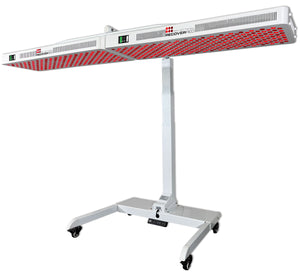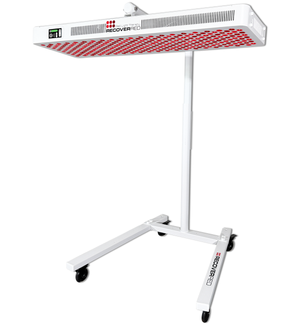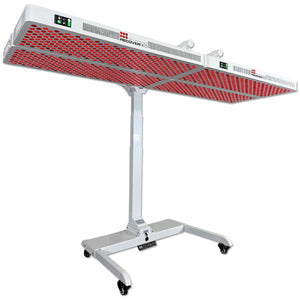Most people tend to think of medicine as slow-moving and stagnant, but the truth is that new treatments (and new uses for old treatments) are emerging all the time. One of the most exciting areas of innovation has to do with two “colorful” therapies: Methylene blue and red light therapy.
While powerful on their own, studies now show that these treatments can become even more effective when combined. So, whether you’re seeking enhanced cognitive function, improved skin health, or faster recovery, the synergy between “red” and “blue” may be the next big thing in holistic wellness.
In this article, we’ll break down how these therapies work, explore their benefits, and show how combining them can support your overall health—especially when paired with at-home solutions from Recover Red.
What is Methylene Blue?

Methylene blue, also known as Methylthioninium chloride, may sound like something out of a science lab, but it’s a tried-and-true compound with over a century of medical use. Originally developed as a dye due to its dark blue color, it quickly gained recognition for its therapeutic properties.
In clinical settings, it has been used to treat malaria, urinary tract infections, and to support memory in neurodegenerative diseases like Alzheimer’s. Methylene blue is a versatile compound with a long history in both medicine and science. What makes Methylene blue so remarkable is its unique role as a redox agent, meaning it can shuttle electrons and support energy production within the mitochondria—the tiny power plants inside your cells.
By improving the efficiency of the electron transport chain, Methylene blue can enhance ATP production, which is vital for nearly every cellular process in the body (keep this in mind for later).
So, what does Methylene blue do? According to studies, it can:
- Boost mitochondrial function by acting as an electron donor.
- Reduce inflammation by blocking harmful cytokines.
- Fight infections thanks to its ability to destroy bacteria, viruses, and fungi.
- Support brain health, potentially aiding in conditions like Alzheimer’s or Parkinson’s disease.
How Does Red Light Therapy Work?
Red light therapy, also known as photobiomodulation or low-level laser therapy, uses wavelengths of light in the red and near-infrared range to penetrate deep into tissues, activating key cellular functions.
At its core, red light therapy works by stimulating the mitochondria, increasing the production of ATP, the energy currency of the cell. This is very similar to the effects generated by Methylene blue, and holds some valuable insight into their potential when used in collaboration.
In RLT’s case, the boost in cellular energy promotes regeneration, reduces inflammation, and supports tissue healing. Studies also reveal that red light therapy also improves blood flow by speeding up the delivery of nutrients and oxygen, and enhances collagen production, making it great for skin, joints, and muscle health.
It seems every few months, there is a new published benefit to red light therapy, with researchers now evaluating its potential to treat things like depression and even cancer. Best of all, unlike traditional heat-based therapies like infrared saunas, red light therapy’s healing effects come directly from the light itself, essentially eliminating potential side effects.
Are There Benefits to Combining Methylene Blue and RLT?

Scientists aren’t generally the type to get excited, but the potential benefits of combining Methylene blue with red light therapy is a notable exception. In fact, many have gone public to claim that this colorful combination represents one of the most exciting frontiers in modern biohacking and wellness.
The truth is, when used together, these treatments create a synergistic effect that dramatically enhances cellular energy and recovery. Here are some of the listed benefits:
- Supercharged Mitochondria – Studies indicate that while Methylene blue helps shuttle electrons in the mitochondria, RLT aids in boosting ATP output. Together, they maximize cellular energy, which is ideal for fighting fatigue, increasing stamina, and enhancing overall vitality.
- Neuroprotection and Cognitive Effects – Though studies are still ongoing, evidence indicates that the Methylene blue and RLT combo supports brain health by reducing oxidative stress and stimulating neuron repair. Users often report sharper focus, improved memory, and better mood, which could help in managing depression or brain fog.
- Pain and Inflammation Relief – Independently, both treatments are capable of reducing inflammation. Combined, they work even better to soothe joint pain, arthritis symptoms, and other chronic inflammatory issues.
- Faster Healing and Skin Rejuvenation – Reports also indicate that Methylene blue’s antimicrobial and regenerative effects pair perfectly with red light’s ability to increase collagen and skin repair. This can lead to fewer breakouts, less scarring, and younger-looking skin.
- Immune Support and Detox – Finally, we know that Methylene blue supports the immune system and may help destroy harmful pathogens, while RLT improves circulation and detoxification pathways. Together, they help the body stay balanced and resilient in the face of attacks.
Methylene Blue and Red Light Therapy: Safety and Precautions
While Methylene blue and red light therapy are both generally considered safe, it’s important to follow proper usage guidelines to minimize risk. For Methylene blue, dosage is key.
Studies have shown that low doses ranging from 0.5 to 4 mg per kilogram of body weight are safe and effective. That said, higher doses can sometimes lead to unwanted side effects such as nausea or dizziness. At
Unfortunately, certain individuals should avoid Methylene blue altogether. People with a rare genetic condition called G6PD deficiency should not use Methylene blue due to the risk of hemolytic anemia. It's also not recommended during pregnancy or breastfeeding.
Finally, it’s always important to consider drug interactions. Among other things, Methylene blue can interact with SSRIs, SNRIs, and MAOIs, potentially leading to serotonin syndrome—a serious condition that requires medical attention.
When it comes to red light therapy, safety largely depends on appropriate use. At Recover Red, we recommend users avoid overexposure by sticking to recommended treatment times and intensities, and always wear eye protection when treating the face or other sensitive areas. Because Methylene blue can increase light sensitivity, users should monitor for signs of skin irritation when using both treatments together.
The bottom line? Always consult a physician before beginning any therapy if you're taking medication or have underlying health issues.
At Home Solutions
When blue meets red, the results are powerful. Methylene blue enhances mitochondrial function, while red light therapy supports healing, inflammation reduction, and cellular energy. Together, they offer a breakthrough approach for brain health, skin rejuvenation, muscle recovery, and beyond.
But the best news of all is that you don’t need to go anywhere to enjoy these incredible results. Though many places offer red light therapy, including gyms, spas, and even Planet Fitness, you can get the benefits of RLT right in your own home.
With devices like the Beam Red Light Therapy Device and the full-body Max Red Light Therapy Panel, you can minimize your costs and maximize your results. These at-home devices are engineered to provide professional-grade results, making it easier than ever to support your health on your own schedule.
If you’re ready to explore the benefits of this innovative combination, Recover Red offers a complete solution.




